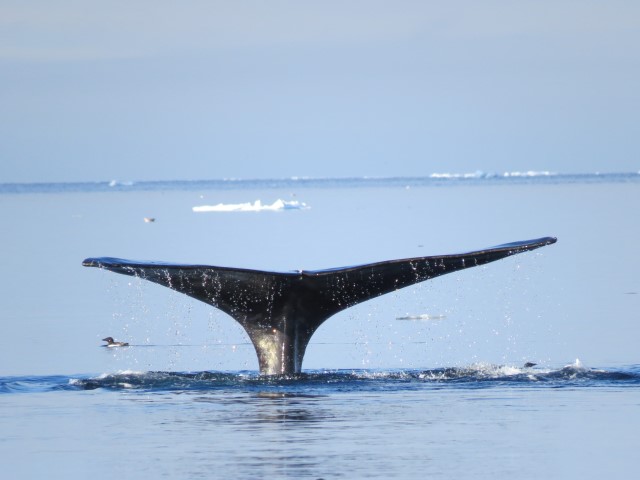This article is reprinted from The Circle 4.14. Parnuna Egede is the Advisor on Environmental Issues for the Inuit Circumpolar Council- Greenland.
The North Water polynya in Baffin Bay is a huge stretch of open water surrounded by ice between Canada and Greenland. This key wintering area attracts abundant numbers of marine mammals such as polar bears and narwhals and numerous seabirds. The mixing of water currents originating from the Atlantic and Pacific causes the upwelling of nutrients to the surface. This triggers plankton blooms, which in turn boost the rest of the food web. Inuit communities are calling for a commission to consult on the protection and future use of this extraordinarily productive polynya.
What makes this polynya one of the most biologically productive in the Arctic is the formation of an ice bridge in Kane Basin north of the polynya. It blocks the otherwise constant flow of sea ice from the Arctic Ocean. When the ice bridge is absent, productivity is much lower. But formation of this ice bridge occurs less frequently now due to climate change.
The ice bridge is not only important biologically, but also historically. It served as an actual bridge for the earliest immigration and settlement of human populations from North America to Greenland beginning in 2500 B.C. up until the middle of the 20th century. This rich biological habitat still sustains Inuit communities on both sides of the bay. It is no coincidence that the Greenlandic name for the North Water polynya is Pikialasorsuaq – “the great upwelling”.
Bridging the Bay
Acknowledgement of the critical importance of Pikialasorsuaq to the Inuit was the impetus for a workshop organized by the Inuit Circumpolar Council – Greenland and co-sponsored by Oceans North Canada on “Pikialasorsuaq – Bridging the Bay” in Nuuk in September, 2013. Over twenty participants attended the two-day workshop.
Inuit hunters and fishermen from communities surrounding the North Water polynya—Pond Inlet, Grise Fiord and Arctic Bay in Nunavut, and Kullorsuaq and Qaanaaq in Greenland—shared their observations on changes in sea ice and snow conditions as well as distribution and behaviour of marine mammals. Scientists from both countries also presented their current understanding of the geology, oceanography, biology and history of this region.
This dialogue served as a basis for the discussion on potential uses and non-uses of the polynya. For example, KNAPK, The Organization of Fishermen and Hunters in Greenland advise halting seismic activities and hydrocarbon exploration offshore of Northwest Greenland. They are concerned about potential harmful effects of these activities on fishing and hunting as well as the environment, and the lack of proper compensation to fishermen and hunters for adverse effects.
The workshop succeeded in “bridging the bay”, creating a strong consensus to explore joint strategies for safeguarding and monitoring the health of this region for future generations. One significant outcome was agreement to work towards creating a joint commission mandated to consult with local communities about the future use and protection of the area.
The ice bridge is not only important biologically, but also historically. It served as an actual bridge for the earliest immigration and settlement of human populations.
Shortcomings of the international process
The input gained from the Pikialasorsuaq workshop was then shared by ICC-Greenland at the Arctic regional workshop to facilitate the description of Ecologically or Biologically Significant Areas (EBSA). This workshop was organized by the Convention on Biological Diversity (CBD) in Helsinki in March, 2014. ICC-Greenland was invited in its capacity as a Permanent Participant of the Arctic Council.
Supported by social and cultural criteria, ICC-Greenland submitted the North Water polynya as a cross-border area fulfilling the criteria of an EBSA. But despite the fact that participating Canadian and Greenlandic/Danish scientists agreed to the importance of the polynya, it was not possible to include it as an EBSA at this level.
The reason seemed to be political reluctance to submit an area that spans national Economic Exclusive Zones for consideration. Since the EBSA process is a national process, it became evident that it falls short when it comes to:
- scientific coordination between states when EBSA are cross-border in nature
- incorporation of input from cross-border Indigenous Peoples’ Organizations
- social and cultural criteria, including significance for Indigenous Peoples
Added value of a commission
In the international process only states can put options on the table and take decisions. ICC-Greenland could only have its submission included in the report as an example of challenges to incorporate indigenous input in the EBSA process. To acknowledge the importance of the North Water polynya in the CBD, Canada and Greenland will have to submit their halves of the polynya into the CBD repository – And hope that the two pieces of the puzzle fits together.
ICC-Greenland believes that a joint commission between Canada and Greenland is the best way to ensure full and active participation of Inuit on both sides of the North Water polynya. The collective input from Inuit will add value along with scientific coordination when working towards gaining EBSA status to the polynya. This will help any conservation efforts strike a proper balance between the socially and culturally important subsistence hunting and the need to protect the habitat for generations to come.
